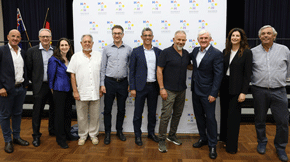Medical wearable monitors
Researchers from the Wolfson Faculty of Chemical Engineering at the Technion-Israel Institute of Technology have developed an integrated system for early diagnosis of diseases using wearable monitors.

Prof. Hossam Haick
Able to continuously monitor physiological indicators without disturbing the user, the system can repair itself in the event of a tear or scratch, and receives the energy required for operation from the wearer.
This could help spare patients much pain and suffering, greatly reduce medical expenses, and provide extensive and detailed information for epidemiological studies. The system was presented in a review paper published in Advanced Materials by Technion Professor Hossam Haick and postdoctoral researcher Dr. Weiwei Wu (who is now a professor at Xidian University in China).

A demonstration of the system that monitors heart rate, peripheral nervous system activity, and other physiological markers, and transfers the data to the cloud where they are available to qualified individuals for analysis and medical recommendations.
Wearable devices for medical monitoring are gaining momentum, because they provide a convenient and inexpensive platform for the continuous collection of medical information without the need for invasive procedures. Such devices enable early disease monitoring, before outbreaks, and earlier and more efficient treatment. They can be attached to shirts, jewelry, sweatshirts, watches, shoes, and glasses, and allow the user to go about his or her day without interruption. As a result, such devices are expected to encourage people to be proactive about their health and to reduce avoidance of medical examinations.
“Normal health is characterized by known markers such as 60 to 100 heart beats per minute and 7 to 8 breaths per minute,” said Prof. Haick. “If we detect dramatic changes in the various markers in real time, we can refer the patient to a more comprehensive diagnosis and prevent disease from developing or worsening.”
The system developed at the Technion contains sensors and tools that process the data and transmit it to the authorized medical authority. It combines a series of innovative elements that provide unprecedented monitoring capability:
-

Dr. Weiwei Wu
A combination of precise sensing and advanced analysis tools
- The energy it requires for operation is derived from the wearer’s body (movements and body heat)
- The device is made of advanced self-healing materials in case of a scratch or cut
The energy derivation and self-repair give the new device a long lifespan, and prevent the need to turn off the system for repair or charging. “This system will not just continuously monitor physiological markers in the wearer. It also aid the long-term collection of extensive information that may be used for epidemiological studies,” said Prof. Haick.
Although the system’s components already exist, a platform that integrates them all has not yet been developed. It requires a complex array of sensors, a tiny and flexible circuit board for measuring the markers, and components that process the information and transfer it to the cloud. All of these are being implemented in the new system being developed by Prof. Haick’s research group.
Photos: Technion spokesperson’s office











